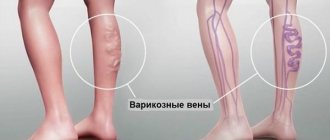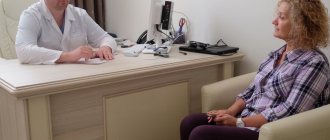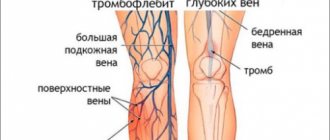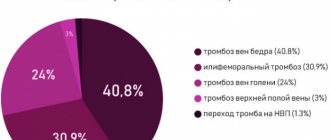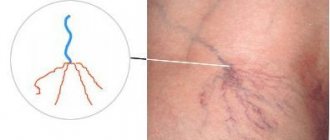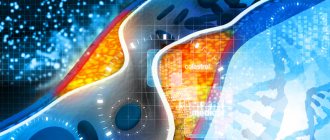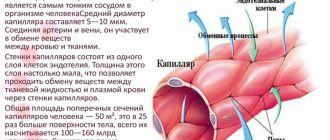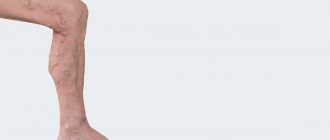Pain in the legs due to varicose veins is a complaint that patients often present when visiting doctors. In the presence of varicose leg pain, phlebologists at the Yusupov Hospital conduct a comprehensive examination of patients using physical and instrumental diagnostic methods. For ultrasound examinations, the latest devices from the world's leading manufacturers are used, which have high resolution and allow the patient to be examined in one, two or three modes.
Conservative treatment of patients who have pain in varicose veins in the legs is carried out with the latest generation of medicines. Their effectiveness and safety have been proven by scientific research. Highly qualified surgeons and the presence of modern equipment and surgical instruments in the phlebology department allow phlebologists to perform operations using both classical and innovative techniques.
Severe cases of varicose veins, when pain due to varicose veins in the legs is not relieved by medications, are discussed at a meeting of the expert council with the participation of candidates and doctors of medical sciences, doctors of the highest qualification category. Leading specialists in the field of diseases of the peripheral venous system collectively decide how to reduce pain from varicose veins of the legs. If pain in a vein in the leg due to varicose veins does not go away as a result of adequate conservative therapy, patients are offered surgical intervention. Surgeons perform the operation only after obtaining the patient's informed consent.
Varicose veins of the lower extremities - what is it?
Varicose veins of the lower extremities - what is it? Why does it appear suddenly and progress so quickly? Today, it is considered a common disease in which there is an abnormal enlargement of veins that are visible through the skin and resemble blue or purple nodes. Varicose veins are a pathology that can occur in any part of the body, but is more common on the legs.
This is how varicose veins appear on the legs
Below are the most common signs of the disease. However, each person may only notice some of them.
What types of exercise are beneficial and which are harmful for problems with veins?
Any dynamic loads, without moving heavy objects, are very useful. These include a treadmill, jogging, walking (especially Nordic walking), and exercise bikes. All this will disperse the existing stagnation in the vessels. As for various exercise machines, it is clear that putting a lot of stress on the legs is harmful, but even lifting weights with your arms strains the abdominal muscles, and this greatly affects the blood flow in the lower extremities. But no one has canceled the health benefits of a pumped-up body and a good muscle corset, so it is advisable to consult with a specialist before classes, and it is better to exercise under the supervision of a trainer. The best exercises for preventing varicose veins are swimming and water aerobics. And in general, any dynamics, any sports and physical education are useful! Even if you have problems with your veins, you don’t need to stop doing what you love, because compression hosiery exists. In general, consult a phlebologist to see if you need any restrictions. Statics, static loads for veins are definitely bad. Work and training with weights is possible, but in compression stockings.
Causes of varicose veins and risk factors?
Blood vessels in the body provide a channel for blood flow. In terms of the blood vessels of the lower extremities, the arteries carry high-pressure, oxygenated blood from the heart to the lower extremities. Veins therefore have thinner and less elastic walls than arteries. If pressure rises in the veins for any reason over a long period of time, this can become the main cause of varicose veins of the lower extremities. The disease is also facilitated by malfunction or damage to the valves that help push blood upward.
The functioning of venous valves normally and with varicose veins
About 30% of adults worldwide suffer from the disease. The risk varies greatly by age and gender. The following are risk factors:
- Obesity. Obesity is a major risk factor for the development of varicose veins of the lower extremities. Excessive weight increases pressure in the veins and aggravates their condition.
- Heredity. Heredity plays an important role in determining susceptibility to varicose veins, but specific factors responsible have not been identified.
- Inaction. Prolonged inactivity or, conversely, increased activity increases pressure in the veins.
- Floor. Women are especially susceptible to varicose veins of the lower extremities due to the effect of progesterone on the veins, as well as the effects of pregnancy. Women have a 3 times higher risk of developing the disease.
- Pregnancy. Varicose veins of the lower extremities during pregnancy occur due to hormonal influences. However, enlarged veins often return to normal within one year after giving birth. Pelvic varicose veins may also be observed.
- Age. Varicose veins of the lower extremities usually affect people between 30 and 70 years of age. As we age, the elastic lining of the vein begins to weaken, increasing the chances of enlarged veins.
A risk factor is anything that can increase a person's chances of developing a disease. This could be due to activities such as smoking, diet and many other reasons.
"Spider" entangling your legs
Varicose veins are the most common vascular pathology, affecting up to 40% of the working population, it is a manifestation of congenital weakness of the walls and valves of the veins and in most cases is hereditary.
Aggravating factors, in addition to hereditary predisposition, are prolonged sedentary standing, pregnancy, and obesity.
Signs of varicose veins are varied and depend on the form and stage of development of the pathological process. External manifestations may include tortuous and dilated subcutaneous venous trunks and their tributaries, swelling of the feet and legs, darkening and thickening of the skin in the ankle area, fragility of blood vessels and a tendency to hemorrhage, trophic ulcers and bleeding from varicose nodes.
The main complaints with varicose veins include a feeling of fatigue and heaviness in the legs, cramps of the calf muscles at night, dull arching pain and swelling, which intensifies with a prolonged vertical position.
Varicose veins of the lower extremities - stages
- First. Spider veins appear;
- Second. Nodules are visible;
- Third. Swelling of the legs is added;
- Fourth. Skin color becomes darker, almost purple;
- Fifth and sixth. Ulcers form, which may not heal as a result.
This is what varicose veins look like in stage II of the disease
Why is arthritis of the ankle and foot dangerous?
The disease is dangerous because it often goes unnoticed and leads to a complete loss of joint function, that is, the person becomes disabled. Acute purulent complications of ankle arthritis are also dangerous.
Arthritis of the foot and ankle begins gradually, unnoticeably
Stages
There are several stages of disease development. The inflammatory process develops gradually, turning into a degenerative-dystrophic one:
- Early – inflammation
. The synovial membrane swells, and inflammatory exudate appears in the joint cavity. Pain is moderate, swelling and redness are absent or only slightly expressed. - Explicit – inflammatory-proliferative process
. The synovial membrane increases in volume, erosions appear on the cartilage, and soft granulations of connective tissue grow in the articular cavity (the process of proliferation - growth). The inflammatory process intensifies. Externally, this is manifested by increased swelling, redness and pain. - Progressive - mild ankylosis
. The cartilage is destroyed, soft granulations turn into dense connective tissue that grows in the joint cavity. Bone growths appear. The joint gradually loses its mobility. Pain, swelling and redness continue to bother you constantly or during exacerbations. - Advanced - complete immobility (bone ankylosis).
There is no cartilage tissue, bone growths connect the articular surfaces of the ankle, which eliminates movement in the ankle and foot (ankylosis of the ankle). The pain is constant, arthritis of the foot develops with limitation of its function.
Possible complications
If ankle arthritis is left untreated or treated independently with home remedies, the following complications may develop:
- purulent processes - abscesses, phlegmon, sepsis;
- subluxations and dislocations of the ankle;
- development of foot arthritis;
- immobility of the ankle and inability to move without assistive devices.
Varicose veins of the lower extremities - diagnosis
In addition to reviewing your medical history as well as a physical examination, testing for vein disease may include the following:
- Duplex scanning is a type of procedure that evaluates the blood flow and structure of the veins in the legs.
- Triplex ultrasound is a procedure similar to duplex ultrasound, which uses color to highlight the direction of blood flow.
- Magnetic resonance venography (MRV) is a diagnostic procedure that uses magnetic resonance technology and intravenous contrast material to visualize veins.
Diagnosis of varicose veins of the lower extremities is carried out with the patient standing
Diagnostics is necessary so that the doctor can prescribe a treatment method that is most suitable for the patient.
General information about the disease
Arthritis of the ankle joint is an inflammatory process that has different origins, symptoms and course. The disease can be independent (primary) or develop against the background of some existing process (secondary). Arthritis is divided into acute and chronic. ICD-10 code M00 – M99.
The ankle joint is a movable joint formed by three bone structures: the heads of the tibia and fibula of the leg and the talus of the foot. To the right and left of the talus are bony elevations - the ankles. The peculiarity of the joint is its resistance to external influences, in this it is much superior to the knee joint. It has a good blood supply and innervation and is protected by ligaments that firmly hold it in the desired position.
Arthritis of the ankle develops at any age. In children it is predominantly juvenile idiopathic arthritis (JIA), in women it is rheumatoid lesions, in men it is reactive arthritis.
Varicose veins of the lower extremities - complications
If varicose veins on the legs are not treated, serious problems may arise in the future, both with the veins and with the skin of the legs.
- Trophic ulcers.
- Phlebitis is inflammation of the veins.
- Deep vein thrombosis (DVT), where blood clots form in the deep veins of the legs. This complication can be fatal.
Because of this, the disease can cause significant discomfort and even disability depending on any underlying tasks and severity. Some of these complications can be very life-threatening.
Let's join hands, friends.
If you find dilated venous nodules, you need to be examined by a phlebologist. A visual examination by a doctor is usually supplemented by the necessary examination - ultrasound duplex angioscanning, based on the results of which the phlebologist will give you the correct diagnosis and will be able to determine further treatment tactics.
Unfortunately, neither drug therapy, nor wearing elastic bandages or compression garments, nor physical therapy can lead to a cure, but only to a temporary slowdown in the progression of the disease, because It is impossible to eliminate the causes of its occurrence in a conservative way. However, conservative measures are indicated and effective in preventing complications when radical treatment is not possible.
Varicose veins of the lower extremities - drug treatment
It is not always necessary, but if you are concerned about pain, ulcers or just discomfort, then, as a rule, you need to go to the hospital. But do not forget about complications, some of which lead to death, therefore, in order not to worsen the general condition, do not ignore treatment and seek medical help if you have varicose veins of the lower extremities. The doctor will explain conservative treatment and its essence.
One of the most popular venotonic drugs
Glue or cut?
Vein sclerotherapy
- Cost: 6,500 rub.
- Duration: 20-60 minutes
- Hospitalization: No hospitalization required
More details
The pages of modern magazines are full of advertisements about the non-surgical treatment of varicose veins, the so-called “sclerotherapy”. However, unfortunately, only rare forms of this pathology are eliminated non-surgically. Surgery remains the radical method. Sclerotherapy (introduction of “gluing” substances into dilated veins) only complements, but does not replace the treatment of varicose veins.
Fear of pain and large postoperative scars sometimes makes patients refuse surgery. Of course, surgery is a certain risk, but the risk of complications if you refuse surgery is much higher. There is an opinion that surgery does not lead to a lasting positive result, and varicose veins reappear even after it is performed. This is not entirely true. The further course of the disease depends on the type of structure of the venous system. There is a group of patients who, after surgery, “forget” about their veins. Another notices the appearance of new dilated ducts. There is no need to be afraid of this. Regular visits to a phlebologist will allow you to get rid of these troubles. And in this case, sclerotherapy takes a leading place.
Varicose veins of the lower extremities, treatment. Operation?
Don't panic if you are diagnosed with varicose veins of the lower extremities. Sclerotherapy treatment may help. This procedure is based on the use of a special solution that is injected into varicose veins. Varicose veins of the lower extremities disappear quite quickly. Sclerotherapy treatment is suitable for treating small veins such as spider veins. Are you afraid of a knife? Varicose veins of the lower extremities can be removed (treatment without surgery). You just need to find a decent doctor.
Varicose veins. Laser treatment in Moscow
Life does not end if you have varicose veins of the lower extremities. Laser treatment will help. The doctor inserts a tiny fiber into the varicose veins through a catheter. The fiber sends out energy that destroys the affected part.
This is a tiny laser fiber that completely eliminates varicose veins
Do varicose veins of the lower extremities remain? Laser treatment, which may seem expensive, is very effective, so the answer is no. Not every patient worries if he has varicose veins of the lower extremities. However, laser treatment leaves only positive reviews. With it, varicose veins of the lower extremities will be defeated! Laser treatment (you will find out the cost at the clinic from the administrator) is short-lived and inexpensive.
Varicose veins. Radio frequency treatment
What to do if you have severe varicose veins of the lower extremities? RFA treatment in Moscow is the safest method, which involves heating the venous wall using radiofrequency energy. Varicose veins of the lower extremities disappear permanently. RFA treatment is very convenient.
How quickly do varicose veins of the lower extremities disappear? RFO treatment in Moscow will convince you of its rapid effect. You will remove varicose veins of the lower extremities. RFO treatment is performed at the highest level. Look at the photos and results - make sure the procedure is effective.
How to treat varicose veins of the lower extremities with ointments
Today, modern drugs can surprise you with their effectiveness and quick results, however, you should not do anything without the advice of a doctor.
- Anti-varicose leg cream – relaxes and relieves pain. Strengthens the walls of blood vessels.
- Heparin thins the blood and helps reduce the formation of blood clots.
- Lyoton 1000 - relieves swelling, strengthens the walls of blood vessels, but does not completely remove varicose veins of the lower extremities. Treatment (the cost of Lyoton is more than that of other creams) in this way is still incomplete.
Of course, the easiest way is to go to the pharmacy and start treatment yourself, however, you don’t need to flatter yourself with hopes that the ointment or gel will provide you with reliable treatment and will not cause complications. Consult a doctor and do not deceive yourself.
Varicose veins of the lower extremities - treatment at home
How unpleasant varicose veins of the lower extremities are! Our grandmothers still use folk remedies to this day, and knowing the effect of medicinal herbs, you can relieve symptoms and strengthen the walls of blood vessels. But make no mistake - serious varicose veins of the lower extremities, treatment, price, results - everything is interconnected.
- Horse chestnut. Dried flowers (50 g) are poured with vodka (500 ml). Let it brew for 20-21 days and take it orally, before meals, 25-30 drops 2 times a day.
- Garlic ointment. Make a paste of garlic and butter. Rub in before going to bed.
- Apple vinegar. 2 tsp dilute in 200 ml of water. Take before meals. This product has good reviews.
It is important to know that varicose veins of the lower extremities (prices, photos, results are available online) cannot be completely removed with herbs.
How to cure varicose veins permanently?
Unfortunately, if you neglect the disease, both you and your doctor will have to work hard to forget about varicose veins in your legs. At the first stage, the disease responds well to any treatment method, but later stages can upset you. You shouldn’t think about how to treat varicose veins of the lower extremities at home. Contact our center and you will be prescribed the right treatment, thanks to which you can get the desired result.
All you need to do is take better care of your health and adhere to basic preventative measures.
Frequently asked questions from our patients on the Internet
How to deal with varicose veins on the legs? Daria from Saratov is interested in:
Dear Daria! It is necessary to combat varicose veins in the legs with the help of good specialists. No matter how promising and colorful the sites with guides and advice on self-medication are, remember, they are written by people far from medicine.
How to check your legs for varicose veins? Svetlana from Kazan asks:
Dear Svetlana! As a rule, it is possible to qualitatively check your legs for the presence of varicose veins only in a clinic or medical center specializing in the treatment of veins.
How to diagnose varicose veins? Interested in Lyubov from Stavropol:
Dear Love! You can diagnose your legs for varicose veins at a consultation with any of our phlebologists with an ultrasound duplex scan of the venous system. How easy is it to do this with us? Make an appointment for a consultation at any time convenient for you by phone.
Compression jersey medi
Thanks to the breathable and elastic material, compression jersey provides high wearing comfort. Modern medical compression hosiery is visually indistinguishable from model hosiery, but provides high medical effectiveness when used.
Here you can find more information about medi compression stockings.
The human body
How do veins work?
Vienna
Product Tips
Ideal compression product
Compression hosiery
